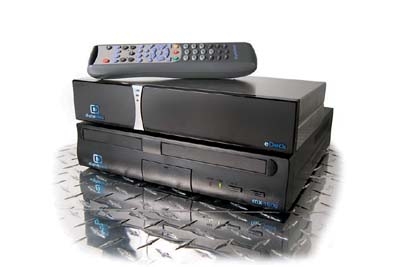Whole-House Magic Page 4

DigitalDeck
Whole-house DVR on steroids
Having minisystems scattered throughout the home is commonplace today. It's not unusual to find a home theater, a separate bedroom system, and maybe a TV in the kitchen, as at my house. More often than not, the TiVo hard-disk recorder, DVD player, satellite receiver, cable box, and other source components are tied to one room, meaning you can't watch everything, everywhere. But what if every TV had access to every source in your home? Think about it - you could start a DVD in the living room and finish it in the bedroom. Or be able to tap all those shows you TiVo'd in the den while you're tidying up the kitchen. Now throw in access to your digital music, photos, and videos, and you've got a good idea what DigitalDeck's DDen Entertainment Network offers.
A base DDen system consists of the MX 1000 server, which has a 200-GB hard drive, and two eDecks placed in remote rooms. An additional eDeck can be purchased for $739. Your TVs, audio systems, and source components connect to the eDecks, which pull content from the server as desired and make your sources available to the network for playback in another room.
SETUP Installing the DigitalDeck system is a little involved, but fortunately my review sample arrived with the company's senior project manager - a real person! - to guide me through the process. If I was an ordinary consumer, I'd likely have the assistance of my dealer, though an experienced enthusiast could probably handle the job alone.
The MX 1000 server has no router functions (which is typical of media servers), so it connects to any available port on your existing router and can be placed wherever you stow your router. On powering up, it assimilates itself into your network automatically and is ready to go.
My review setup included the current maximum number of three eDecks - sleek, gloss-black boxes with a sexy blue LED. Each can support up to four A/V sources, which are controlled by the eDeck via an infrared (IR) blaster. One input supports S-video and the other three composite video only; the system can't pass high-def or digital video signals. The eDeck has component-video and digital audio outputs (both optical and coaxial) to run to your TV and audio system.
We connected the cable box in my home theater to one of the eDecks along with the Escient DVDM-300 DVD manager I reviewed in June (see "Serve It Up!"). I connected the standalone cable tuner in my bedroom to another eDeck. The third eDeck connected to my kitchen iCEBOX - a combination LCD TV, DVD player, and Internet browser (see "Kitchen Cool Factor"). Basic configuration is required for each eDeck, such as naming it for easy identification on the onscreen menus, specifying your cable/satellite provider and channel lineup, and identifying components in order to load the proper IR codes from the onboard library.
PERFORMANCE The MX 1000 appears under "My Network Places" on networked computers, and files are added in the standard drag-and-drop manner. Sadly, video files recorded via the system can't be transferred off the server. This is a real bummer, since burning recorded TV shows to a DVD or transferring them to a portable player would be a great bonus.
- Log in or register to post comments



































































